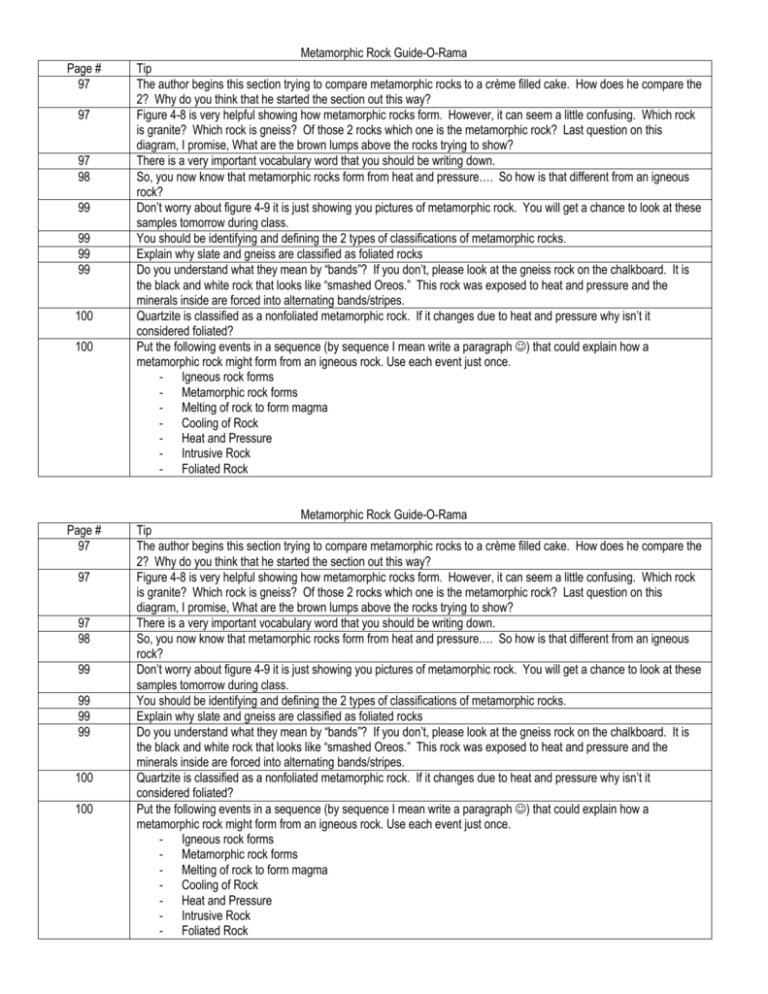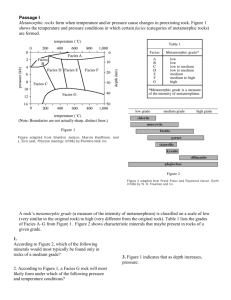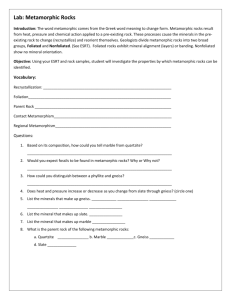Metamorphic Rock Guide-O-Rama
advertisement

Page # 97 97 97 98 99 99 99 99 100 100 Page # 97 97 97 98 99 99 99 99 100 100 Metamorphic Rock Guide-O-Rama Tip The author begins this section trying to compare metamorphic rocks to a crème filled cake. How does he compare the 2? Why do you think that he started the section out this way? Figure 4-8 is very helpful showing how metamorphic rocks form. However, it can seem a little confusing. Which rock is granite? Which rock is gneiss? Of those 2 rocks which one is the metamorphic rock? Last question on this diagram, I promise, What are the brown lumps above the rocks trying to show? There is a very important vocabulary word that you should be writing down. So, you now know that metamorphic rocks form from heat and pressure…. So how is that different from an igneous rock? Don’t worry about figure 4-9 it is just showing you pictures of metamorphic rock. You will get a chance to look at these samples tomorrow during class. You should be identifying and defining the 2 types of classifications of metamorphic rocks. Explain why slate and gneiss are classified as foliated rocks Do you understand what they mean by “bands”? If you don’t, please look at the gneiss rock on the chalkboard. It is the black and white rock that looks like “smashed Oreos.” This rock was exposed to heat and pressure and the minerals inside are forced into alternating bands/stripes. Quartzite is classified as a nonfoliated metamorphic rock. If it changes due to heat and pressure why isn’t it considered foliated? Put the following events in a sequence (by sequence I mean write a paragraph ) that could explain how a metamorphic rock might form from an igneous rock. Use each event just once. - Igneous rock forms - Metamorphic rock forms - Melting of rock to form magma - Cooling of Rock - Heat and Pressure - Intrusive Rock - Foliated Rock Metamorphic Rock Guide-O-Rama Tip The author begins this section trying to compare metamorphic rocks to a crème filled cake. How does he compare the 2? Why do you think that he started the section out this way? Figure 4-8 is very helpful showing how metamorphic rocks form. However, it can seem a little confusing. Which rock is granite? Which rock is gneiss? Of those 2 rocks which one is the metamorphic rock? Last question on this diagram, I promise, What are the brown lumps above the rocks trying to show? There is a very important vocabulary word that you should be writing down. So, you now know that metamorphic rocks form from heat and pressure…. So how is that different from an igneous rock? Don’t worry about figure 4-9 it is just showing you pictures of metamorphic rock. You will get a chance to look at these samples tomorrow during class. You should be identifying and defining the 2 types of classifications of metamorphic rocks. Explain why slate and gneiss are classified as foliated rocks Do you understand what they mean by “bands”? If you don’t, please look at the gneiss rock on the chalkboard. It is the black and white rock that looks like “smashed Oreos.” This rock was exposed to heat and pressure and the minerals inside are forced into alternating bands/stripes. Quartzite is classified as a nonfoliated metamorphic rock. If it changes due to heat and pressure why isn’t it considered foliated? Put the following events in a sequence (by sequence I mean write a paragraph ) that could explain how a metamorphic rock might form from an igneous rock. Use each event just once. - Igneous rock forms - Metamorphic rock forms - Melting of rock to form magma - Cooling of Rock - Heat and Pressure - Intrusive Rock - Foliated Rock Today’s Agenda 1. Igneous Rock Quiz 2. Finish Igneous Rock Lab (if applicable) – DUE TODAY BEFORE YOU LEAVE!!! 3. Metamorphic Rock Reading using Guide O Rama 4. Metamorphic Rock Classification 5. Read Science Journal/Magazine if you finish with 1-4.








